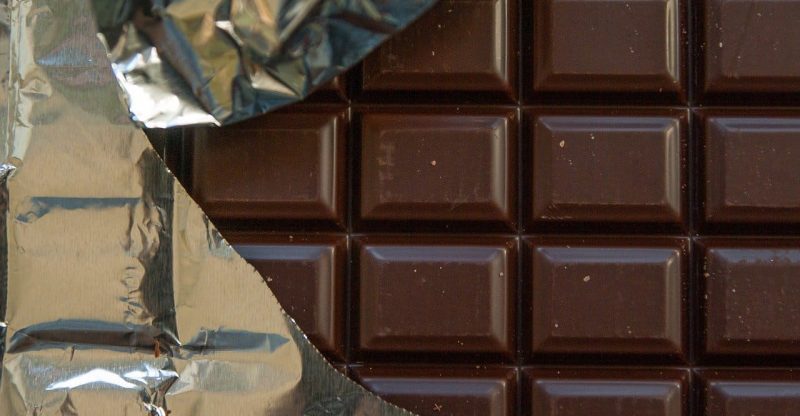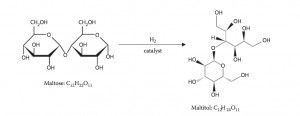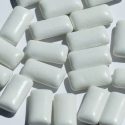What is Maltitol (E965) in Food? Uses, Health benefits, Safety, Side Effects

What is maltitol | Health benefits | Uses | Safety | Side Effects | FAQs
Maltitol, a sugar alcohol (or polyol) primarily used as a sugar substitute in sugar/calorie reduction food categories such as candies, chewing gum, chocolates, ice cream and baked goods for its sweetness similar to sugar and low calories. The European food additive number E965 refers to both maltitol crystalline and syrup.
What is maltitol?
It is a disaccharide sugar alcohol composed of a molecule of glucose linked with a molecule of sorbitol. There are two types in the market: crystalline powder and syrup. They are obtained by hydrogenating d-maltose or glucose syrup which are made from starch.
The sweetness about 75%-90% of sucrose and produces low calories after digestion.
Two types in market
It is available in both crystalline powder (E965i) and syrup or solution (E965ii). E965i can be used to replace sugar while E965ii can substitute glucose syrup.
1. Crystalline maltitol
The hydrogenated maltose, mainly composed of D-maltitol (not less than 98% in dry basis) and may contain small amounts of sorbitol and related polyhydric alcohols.
The high purity of powdered form enables it added directly in food, plus it is safer as easy to transport than the liquid, the market demand for it is higher than the syrup.
However, it’s complex to refine pure maltitol for the high quality requirement of raw material d-maltose is needed during the production process because the higher the purity of d-maltose, the higher the purity of the hydrogenated product. That’s why it is more expensive than sorbitol.
2. Maltitol syrup
A hydrogenated glucose syrup, mainly made of d-maltitol (not less than 50% in dry basis), with more content of sorbitol and hydrogenated oligo- and polysaccharides.
There are various syrups in the market with different maltitol content for specific applications. It has a higher hygroscopicity property than that of crystalline powder.
What is it made from?
Mainly produced from corn starch. It also can be derived from other starch sources, such as tapioca, potato and wheat.
How is it made?
- Crystalline maltitol: commercially produced by the hydrogenation of d-maltose, which is obtained by enzyme conversion of starch. The manufacturing processes can be divided into two major steps: the first step is to hydrolyze the starch into maltose syrup, and in the second step, maltose syrup is reduced by hydrogenation to maltitol.
- Maltitol syrup: manufactured by catalytic hydrogenation of high maltose-content glucose syrup.
The following is the hydrogenation reaction:

From ResearchGate
What are the health benefits?
Maltitol has the same benefits as other sugar alcohols:
Low Glycemic index
A large part of ingested maltitol is fermented in intestinal (1) and only a small part of it is hydrolyzed to sorbitol and glucose which will lead to glycaemic response while sorbitol does not. (2).
The glycemic index of crystalline maltitol is 36 and the GI for the syrup is 52 (3) as the content of higher hydrogenated oligosaccharides in it. So it does raise but not spike blood sugar than sucrose.
It has the highest glycemic index among sugar alcohols, such as sorbitol, erythritol, xylitol, and mannitol. This sweetener is suitable for diabetics as the insulin response level after its consumption is reduced compared with sucrose, but people with diabetes should be careful as it can affect blood sugar.
Low calories
2.1 calories per gram (4), half of table sugar. So it can reduce 50% of the calories in food compared with sugar.
Tooth friendly
It is a non-cariogenic carbohydrate and will not be metabolized by oral microorganisms (such as streptococcus mutans) to convert it to acid to promote dental caries and so that can be used to substitute sucrose and corn sweeteners in confectioneries.
Specification
Other Names
- D-Maltitol
- Maltitol solution
- (α)-D-Glucopyranosyl-1,4-D-glucitol
CAS Number
585-88-6
Chemical Formula
C12H24O11
Molecular Weight
344.3
Melting point
135 to 140 ℃
Properties
- Hygroscopicity: for moisture retention in food.
- Stable to heat, acid and alkalis.
- Viscosity: the more purity the syrup, the lower the viscosity.
- No browning (Millard) reaction: no aldehyde groups like sugar so it will not react with amino acids or proteins to caramelize or brown when heated.
- No cooling effect taste: maltitol is the sugar alcohol that dissolves in water with the least amount of heat absorption at 20 degrees. Therefore, there is almost no cooling mouthfeel.
- Not function as a humectant in its main applications.
Appearance
- White crystalline powder
- Colourless, odourless and clear viscous liquids
Sweetness
The sweetening power of the crystalline powder is 90% of sucrose, and the sweetness of syrup is about 75% of sucrose. Taste close to sucrose, no off-flavors, no unpleasant aftertaste, and can mask the metal after taste of high intensity sweeteners such as saccharin.
Solubility
Freely soluble in water, 100g/165g water. Sparingly soluble in methanol, ethanol, and insoluble in organic solvents such as chloroform and ether.
What are the uses?
Maltitol can be used as a functional sweetener in special food for diabetics, anti-caries and low-calories. In addition, the high sweetness than other sugar alcohols (except xylitol), plus the taste characteristics close to sucrose make maltitol can directly replace sucrose in a variety of sugar-free foods.
Commonly, it may be found in the following food:
- Baking products: bread, biscuits, cookies
- Confectionery: chewing gum, chocolate, gummy bears
- Dairy products: ice cream, dessert, yogurt
- Cereals & snacks: cereal bars, breakfast cereals
Sugar-free foods
Sugar-free foods are recognised as health products in which sucrose, fructose, and maltose are replaced by sugar alcohols and/or artificial sweeteners which are not easily absorbed by the human body, and without cause tooth decay, obesity and high blood sugar.
They provide a similar taste of sugar, but without/less calorie, and at the same time good for health.
In the market, the sugar-free foods people are most exposed are sorbitol and xylitol. The price of maltitol is cheaper than xylitol and can substitute xylitol in most of its uses.
Maltitol is commonly used in sugar-free confectionery, e.g. chewing gum coating, chocolate, and hard & soft candy production.
Candy
It can be used as a sweetener for sugar-free soft candy and prevent other polyols in the formulation from crystallizing. Candy made with maltitol has better chewing feeling and lower stickiness.
Chewing gum
Maltitol is very often used in chewing gum coating and mass (for soft gums) to offer a crunchy texture and a glossy surface. Its powder can be directly compressed to make chewing gum tablets. Meanwhile, it maintains the crunchy texture and glossy appearance of maltitol coated tablets for the low hygroscopicity property.
Chocolate
Crystalline maltitol is a widely used ingredient to reduce sugar and calorie in sugar-free chocolate due to its low hygroscopicity, high sweetness and no cooling aftertaste. The taste of sugar-free chocolate made with maltitol is very close to that of sucrose chocolate.
All polyols can be used in the production of sugar free chocolates, but most of them bring negative effects compared with maltitol. For example,
- Isomalt and lactitol are the least sweet in sugar alcohols.
- Sorbitol and mannitol are lack of sweetness and bring cooling taste which is not desired in chocolate.
- Xylitol has the same sweetness as sugar but also with the cooling effect.
Ice cream
It can be used as a fat substitute and a sugar replacement in ice cream and frozen dairy food to make the product sweet, sticky, creamy, and long shelf life. Meanwhile, maltitol can make the freezing point and sweetness of no added sugar ice cream similar to that of full-sugar ice cream for its approximately the same molecular weight with sucrose.
Bakery
Maltitol is a disaccharide sugar alcohol that absorbs water during dough formation and has a certain ability of water retention. The addition in bread can help ensure a good taste during storage and extend the shelf life.
Meanwhile, maltitol prevents browning and makes the color, volume and crispness of bakery products similar to traditional products using sugar.
Is maltitol safe?
Yes, its safety when used as a food additive has been approved by the U.S. Food and Drug Administration (FDA), European Food Safety Authority (EFSA), Joint FAO/WHO Expert Committee on Food Additives (JECFA), as well as other authorities.
FDA
Maltitol and maltitol syrup have not generally GENERALLY RECOGNIZED AS SAFE (GRAS) as food additives but are self-affirmed GRAS based on petition to the FDA. (5)
EFSA
Maltitol E965(i) and maltitol syrup E965(ii) are listed in Commission Regulation (EU) No 231/2012 as an authorised food additive and categorized as “sweeteners”. (6)
Authorised Uses And Use Levels
Its application is listed in Group I with the usage of “quantum satis”. It can also be used as a carrier in all food additives and nutrients for the purpose other than sweetening. (7)
UK Food Standards Agency
Categorized in “Sweeteners” (8)
Food Standards Australia New Zealand
In Australia and New Zealand are all with the code number 965. (9)
JECFA
Functional Class: food additives, sweetener, bulking agent, humectant, stabilizer. (10) (11)
Acceptable daily intake: ADI “not specific” set in 1993 and 1997. (12) (13)
What are the possible side effects?
It is common that sometimes consumers have health concerns whether maltitol is bad for our health and what are the possible side effects. It is generally considered safe but some people may be allergic to it and large amounts may cause laxative effects.
Possible side effects
A study showed that desserts with maltitol may cause discomfort like flatulence (gas), borborygmi and bloating. (14)
Laxative effects
Like other sugar alcohols, too much consumption may have a laxative effect and may cause gastrointestinal intolerance, e.g. gas, bloating and diarrhea. A study demonstrated that osmotic diarrhea frequency appeared at the doses of maltitol about 90 g and transitory osmotic diarrhea was caused at a dose of 45 g. (15)
Is maltitol safe for dogs and cats?
Yes, it is generally considered safe while xylitol may do bad to dogs.
Is it safe for pregnant?
Yes, it is generally safe but better consult your doctor in the condition of use.
Frequently asked questions
Is it a natural sweetener?
No, it is commercially made from chemical synthesis as mentioned above. Only erythritol is the natural sweetener among all sugar alcohols.
Is it an artificial sweetener?
No, artificial sweeteners commonly refer to aspartame, sucralose, neotame, saccharin, and acesulfame k.
Is it Halal?
Yes, it is generally recognised as halal as it is permitted under the Islamic Law and fulfill the conditions of Halal. And we can find some manufacturers certificated with MUI halal.
Is it Kosher?
Yes, it is kosher pareve. E965 meets all the “kashruth” requirements and can be certified as kosher.
Is it Vegan?
Yes, it is vegan friendly as a corn derivative and the manufacturing process without the use of animal matter or products derived from animal origin. So it is suitable to add it to the diet of vegetarians.
Is it GMO?
No, it is GMO free as the raw material starch comes from non GMO plants, and the importers always need GMO free documents.
Is it Gluten Free?
Yes, it is a common ingredient in both gluten-free and gluten-containing food labels. Maltitol made from corn and other sources except wheat complies with the FDA’s definition of gluten free, that it does not contain wheat, rye, barley, or crossbreeds of these grains. And it is generally considered safe for people with celiac disease.
Conclusion
Now I think you may have a good knowledge of the sweetener – maltitol (E965), from its two types: crystalline powder and syrup, production process, health benefits, uses, approved safety and possible side effects. Also you may be clear with some common FAQs such as is it gluten free, synthetic or natural.
What kinds of food packaging have you found this additive in? Let me know in the comments.



in Robitussin(cough medicine)
In a high protein – no added sugar -natural colours and flavours -no preservatives- gluten free 15g tub chocolate pudding .
I come here because I have a chocolate bar say sugar free and e965i